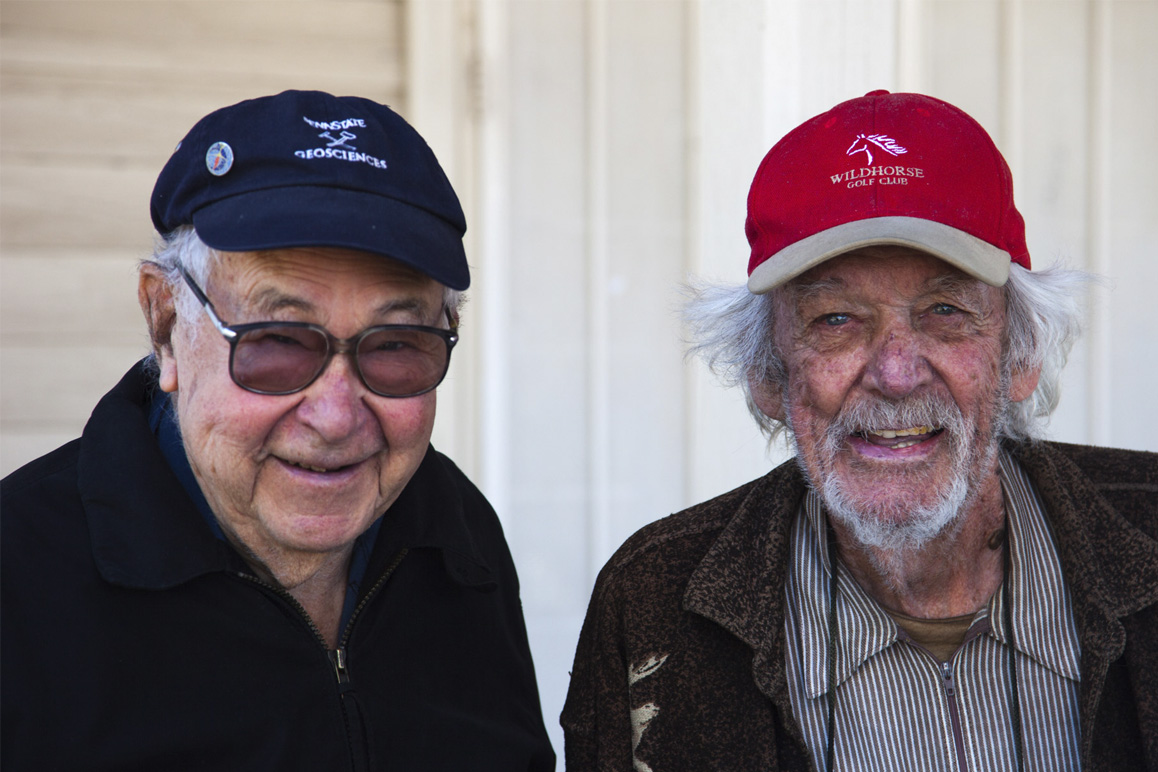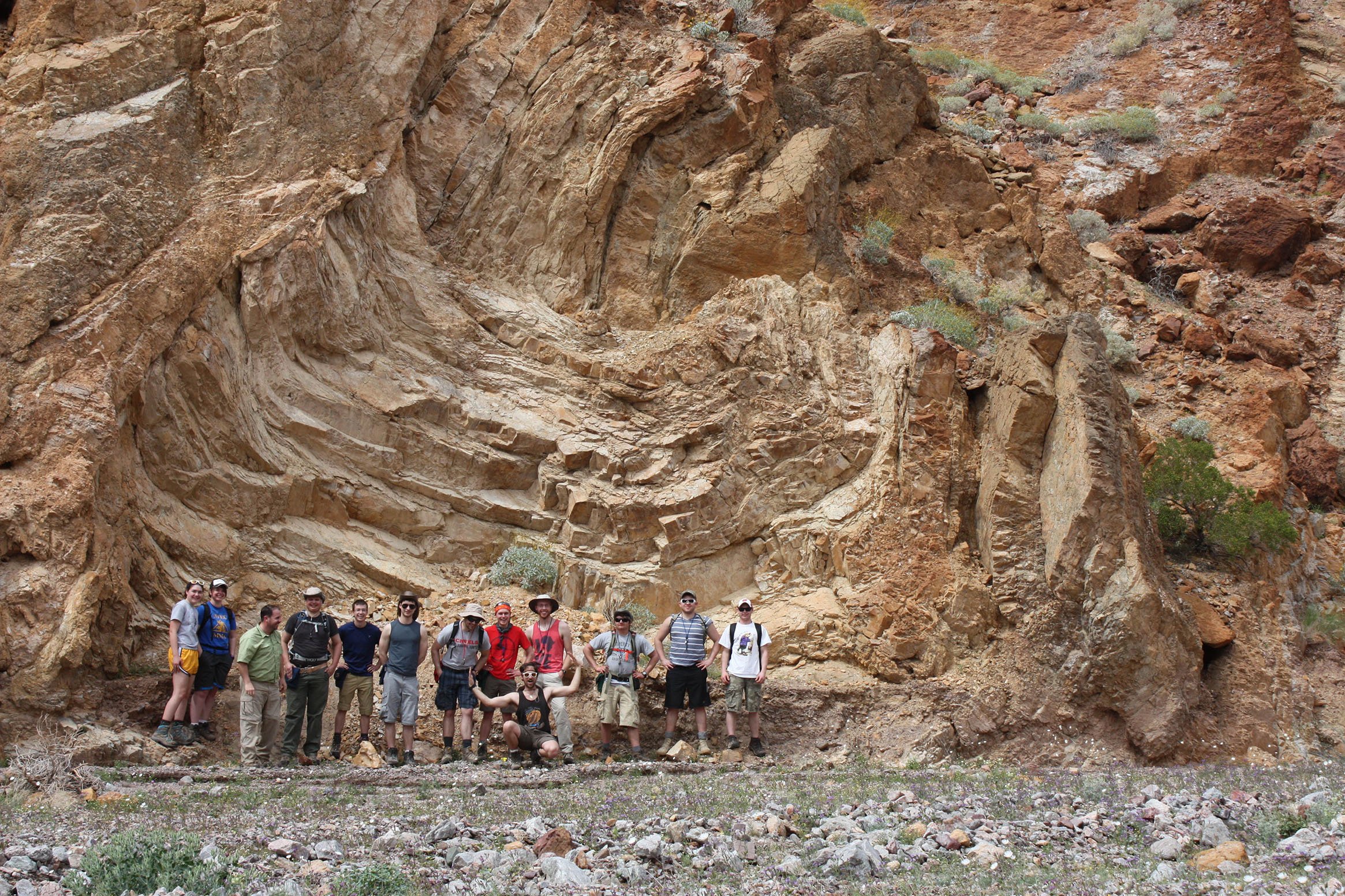I’m in the Chaos right now, Lauren and Bennie’s map in hand, futilely trying to understand how the rocks fit back together. In most places, you can rely on a few basic rules to understand geological history. We know, for example, that most sedimentary rocks form as extensive, horizontal layers of sediment like sand or gravel or mud. We understand that the oldest layers, called “beds,” are the ones at the bottom of the stack. So, if the beds get broken and crumpled during a mountain-building period, we can apply those rules to figure out what happened.
Here, many of the rocks are sedimentary, so the same rules should apply—but the place is so thoroughly broken up and shuffled that nobody’s been able to put everything back in its place. Lauren once said, “Yeah, we got so confused that we gave up for a while and worked on a map in the Funeral Mountains. Then we came back and…oh boy…Chaos!” His laugh punctuated the thought.
Bennie added, “We kept finding these spoon-shaped faults [where] the rocks slid along them and rotated. And when we mapped them, they seemed to be all over the place!”
I remember those times well and fondly. Lauren and Bennie each had a place in the tiny town of Shoshone, California, just east of Death Valley. Bennie lived in a small tan-colored house. Lauren lived in a green trailer. Bennie loved sharing his knowledge with visiting field-trip groups, telling stories to the students and faculty, sometimes taking them into the field. He earned a reputation for making offhand remarks we called “Bennie-isms.” During one field trip, he turned around and said to us in the back of his truck, “You’re only allowed to say ‘oh wow!’ once.”
And Lauren. He and I would sit at the kitchen table in his trailer for hours, talking about anything and everything: relationships, regional geology, his early days in Death Valley. So often, he’d speculate on humans’ ability for self-reflection. These conversations took off on those occasions when we drove the thirty or so miles from Shoshone to Pahrump, Nevada, for a nice dinner over a bottle of wine.
Chaos is a structural term for a mosaic of fault-bounded, typically gigantic blocks, derived from a stratigraphic succession and arranged in proper stratigraphic order, but occupying only a small fraction of the thickness of the original succession. In the Death Valley region, where Levi Noble coined the term, Chaos is normally viewed as a product of extreme crustal extension.[2]

Located approximately two miles east of Jubilee Pass on California State Route 178 on the south side of the road, Exclamation Rock shows an excellent example of the Amargosa Chaos in Death Valley’s southern Black Mountains. On view are parts of four different rock units, including the Proterozoic Crystal Spring Formation of the Pahrump Group shown in the cliff’s midsections and the Cambrian era Noonday Dolomite overlying at the top. These rock units are in proper stratigraphic order; however, they are one-tenth their original thickness of 500 to 2,000 feet, suggesting that they underwent extreme faulting over millennia thus creating geological “chaos” as coined by Levi Noble in his 1941 paper. Photo: Kim Stringfellow.
I measure the orientation of a distinctive red sandstone bed. It’s tilted some thirty degrees towards the north. However, less than ten feet away, a yellowish bed lies at a completely different angle. A fault surface occupies a narrow zone between them, and just down the gully, another fault separates the yellowish rock from some gray siltstone. Using my hand lens, I look closely at the sandstone and see that it’s nearly 100 percent quartz—tiny rounded grains of quartz—and I can almost hear Bennie saying, “You can feel them squishing between your toes on a beach!”
I marvel at these rocks. The sand was deposited in a shallow ocean or coastal area some 600 million years ago during the Proterozoic Era, before the existence of shell-producing organisms such as corals and trilobites. 600 million years? What does that even mean? Lauren and Bennie each lived into their nineties, having accumulated as much experiential wisdom as probably any human. But from the standpoint of Earth history, their time here was vanishingly short. For that matter, so is the length of time our species has been around—some 300,000 years. And to think that our planet is some 4.55 billion years old makes even these rocks seem young.
I guess you could say these rocks also have experiential wisdom. Indeed, a lot has happened to them since their sand, gravel or mud particles were deposited. For one thing, the loose sediment first had to turn into rock—no simple task. In addition, most sediment gets eroded from a site after it’s deposited, so to be preserved, it has to get buried by more sediment, then compacted and cemented, typically by mineral-precipitating groundwater.
By measuring the thicknesses of the younger sedimentary rocks, geologists had determined that before the end of the Paleozoic Era 252 million years ago, these rocks had been buried under more than 20,000 feet of younger limestone, dolomite, shale and sandstone. Just like their vast ages, a thickness of 20,000 feet strikes me as incomprehensible. To attain such a thickness, the Earth’s crust on which the sediment was deposited had to sink further as the sediment piled up above it gradually. From all indications, the sediment accumulated on an extended, vast continental shelf.
And so much has happened since! In many places throughout the Death Valley region, you can see how the Paleozoic rocks were either folded or broken by fault zones that brought older rock up and over younger, shallower rock—both tell-tale signatures of the compressional mountain building affecting western North America during the Mesozoic Era. After that, beginning in Death Valley, maybe 14 million years ago, the region was pulled apart. This crustal extension caused the valleys to drop and mountains to rise along normal faults, leading to the eventual formation of the modern landscape of parallel valleys and mountains we call the Basin and Range. In contrast to the thrust faults of the Mesozoic, normal faults carry younger rock down over the older rock. The two faults in this gully are normal faults—and just like Bennie said, they seem to be everywhere.
But the Chaos is different from most Death Valley geology. It hosts only a fraction of the Paleozoic sedimentary sequence and its myriad of normal faults obscure the Mesozoic compressional features. In fact, after studying Lauren and Bennie’s map, many Death Valley geologists concluded that crustal extension was the culprit, arguing that the entire sedimentary sequence detached from the underlying metamorphic basement rock along a single fault. Movement along the fault then broke the rock into its chaotic fashion. This hypothesis provided an elegant way to explain how everything transpired within a single event. However, it ignored one of Lauren and Bennie’s principal observations: many of the sedimentary rocks were still in depositional contact with the basement and had not moved. Therefore, a single fault couldn’t explain everything—which piqued my interest and led me into the area in the first place.

Lauren Wright (left) and Bennie Troxel (right) and in 2009 photographed by the author.
Just as Lauren and Bennie helped mentor me in my field studies, I mentored several young geologists during their research studies in Death Valley. One of them, Sammy Castonguay, worked in the Chaos. Sammy brought more energy and enthusiasm into his work than I’d seen in a long time and consequently expanded Lauren and Bennie’s original map with exciting new detail. Among other things, Sammy found thrust faults and folds, likely formed during the Mesozoic compressional mountain building, along with three later generations of extension-related faults, which together brought more chaos to the Chaos. In short, he teased out more mysteries of the Chaos than anybody had done before.
Sammy never met Lauren, who passed away at his home in State College, Pennsylvania, in February 2013. But Sammy did meet Bennie, along with many other Death Valley geologists the following month in Shoshone when we got together to remember our old colleague. In typical fashion, we started the day with a field trip to a couple of Lauren’s favorite places. Afterward, we gathered for a lovely outdoor remembrance. Four years later, Bennie died, and Sammy was there again—this time with his daughter Neva. Another field trip, another memorial, but this one ended an era. Lauren Wright and Bennie Troxel, whose names were synonymous with Death Valley geology, were both gone. We ended our tribute with a round of cold, canned beer, Bennie’s favorite.
I pause at a freshly exposed rock face where a large block of sandstone fell away from the cliff. Sometimes I feel like that fallen block—other times like that freshly exposed face. I smile as I remember Lauren and Bennie returning from a day in the field together—maybe twenty-five years ago when they were in their mid-seventies—and hearing Bennie exclaim: “We felt like a pair of sixty-year-olds!” Funny how I can relate to that now. I was in my mid-twenties when I met those two and felt like I could go anywhere and everywhere. Lauren and Bennie were already in their early mid-sixties and seemed to take a decidedly more thoughtful and measured approach to their fieldwork. Now, only a few years shy of their ages when I first met them in 1984, I can see how much I’ve slowed down. I like to think that my approach today is similarly thoughtful and measured.
I often wonder what Lauren and Bennie were like when they were young, freshly exposed faces themselves. Lauren often talked about his own mentors: Ben Page, Olaf Jenkins, Ian Campbell, Dick Jahns, Levi Noble. Lauren called these men “heroes.” During the 1950s, both Lauren and Bennie assisted Levi Noble in the field, who published the first description of the Chaos some ten years before. I would think Levi enjoyed their youthful energy, just as I imagine Lauren and Bennie enjoyed mine—just as I take pleasure in the ardor of my students today. And Sammy, who still exudes an incredible drive, now happily comments on the unbridled enthusiasm of his students.

Geologist Sammy Castonguay (kneeling) with students in the Amargosa Chaos. Photo: Geoff Pignotta.
I sense a parallel between our human lives and this sandstone—but at incomprehensibly different scales of time. The block that recently detached from the cliff lies among numerous others, each having broken loose at various times over the past few thousand years or so. The most recently fallen pieces still have sharp edges and are mostly intact, whereas the older ones tend to be more rounded. Gradually these will dissolve back into the landscape. Meanwhile, the freshly shorn rock face confronts the elements head-on. Then, in a geological instant, it, too, will spall off, leaving behind another new surface, repeating this pattern interminably over time.
Marli B. Miller is a senior instructor and researcher in geology at the University of Oregon. She completed an MS and Ph.D. in structural geology in 1987 and 1992, respectively. She teaches a variety of courses, including structural geology, field geology and geophotography. Visit Bennie Troxel’s “Trail Through Time,” a sequenced collection of regional rock samples with interpretive panels that tell the story of Death Valley’s geological history, at the Shoshone Museum in Shoshone, California.
This article is co-published with KCET Artbound. Visit Artbound’s Mojave Project page here.
Did you enjoy reading this dispatch? Consider supporting us with your tax-deductible donation.
Click here to learn more.
FOOTNOTES (click to open/close)
[1] Lauren A. Wright and Bennie W. Troxel, “Levi Noble: Geologist His Life and Contributions to Understanding the Geology of Death Valley, the Grand Canyon, and the San Andreas Fault,” U.S. Geological Survey, (Open-File Report 02-422): 24.
[2]Marli Miller and Lauren A. Wright, Geology of Death Valley: Landforms, Crustal Extension, Geologic History, Road Guides (Dubuque, IA: Kendall Hunt Publishing Co., 2015), 36.
